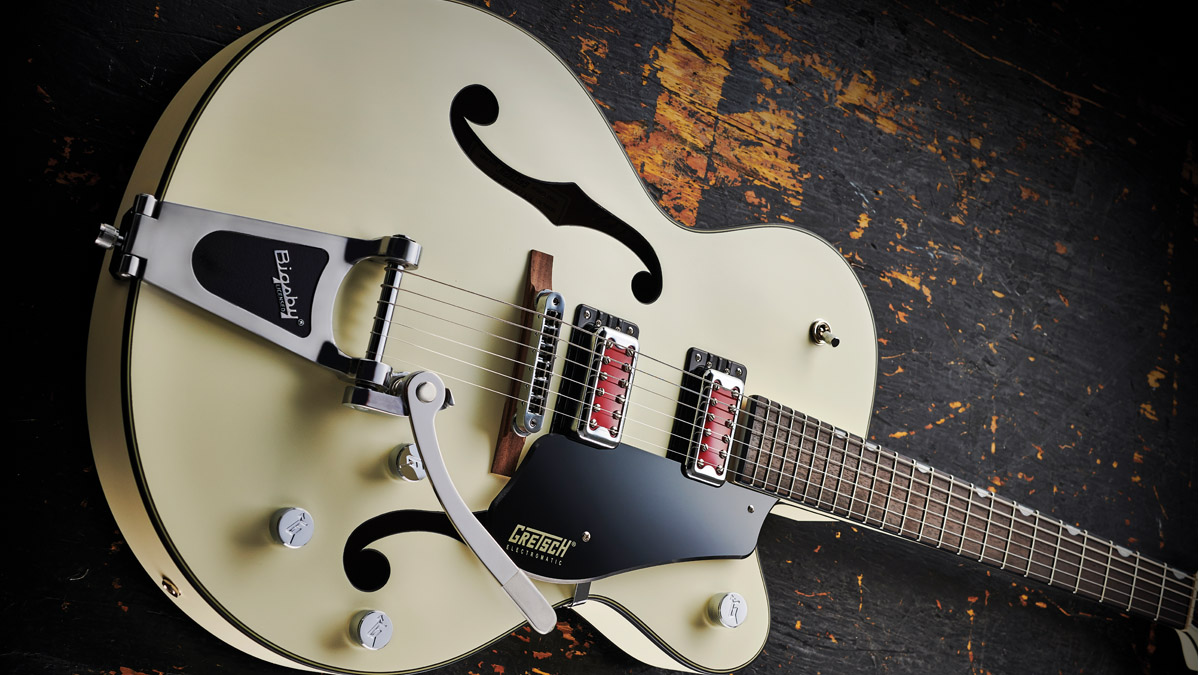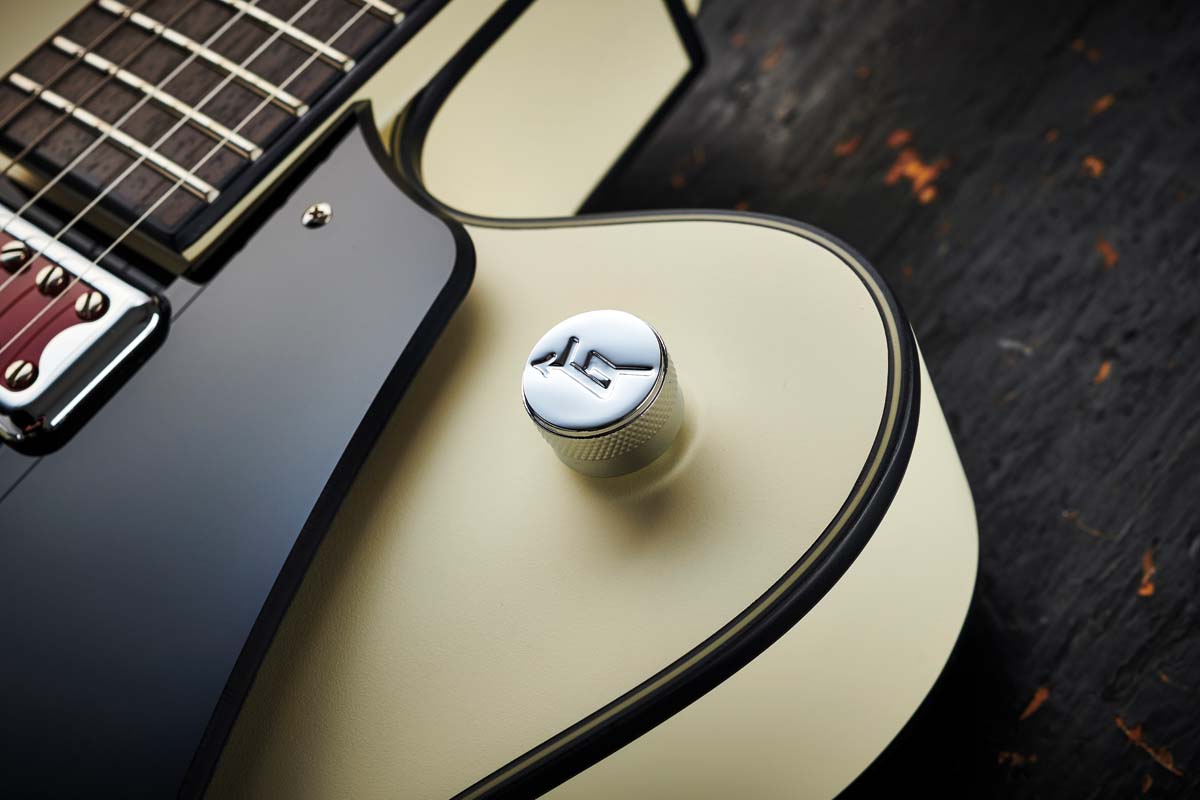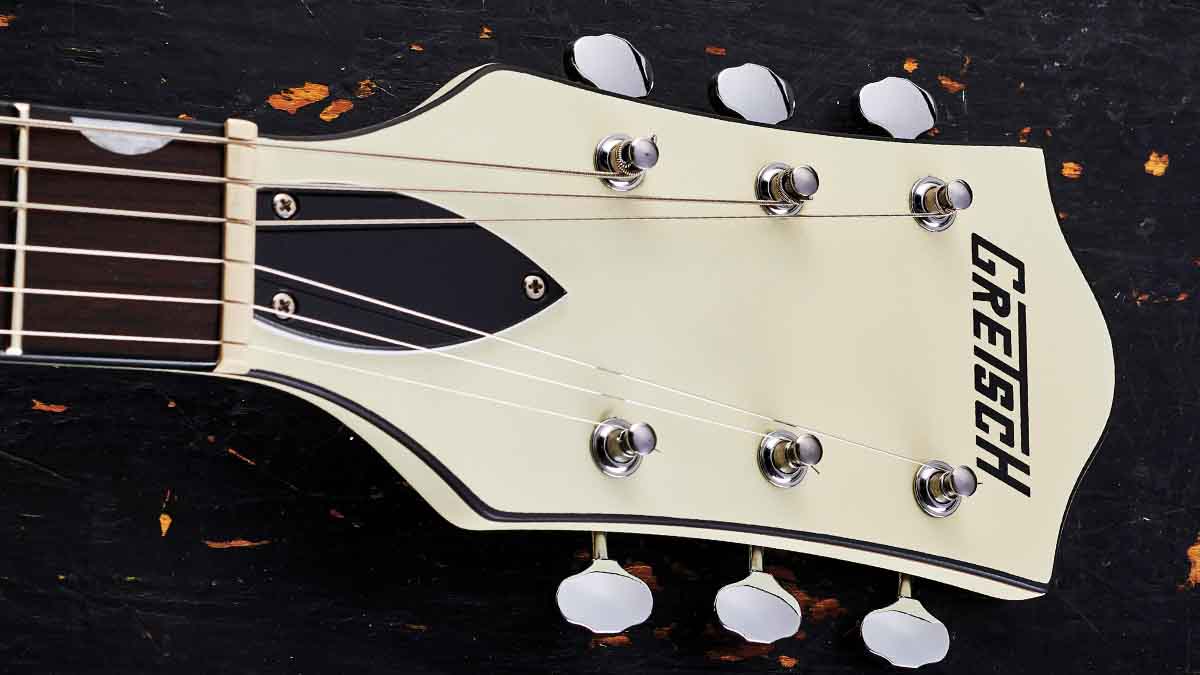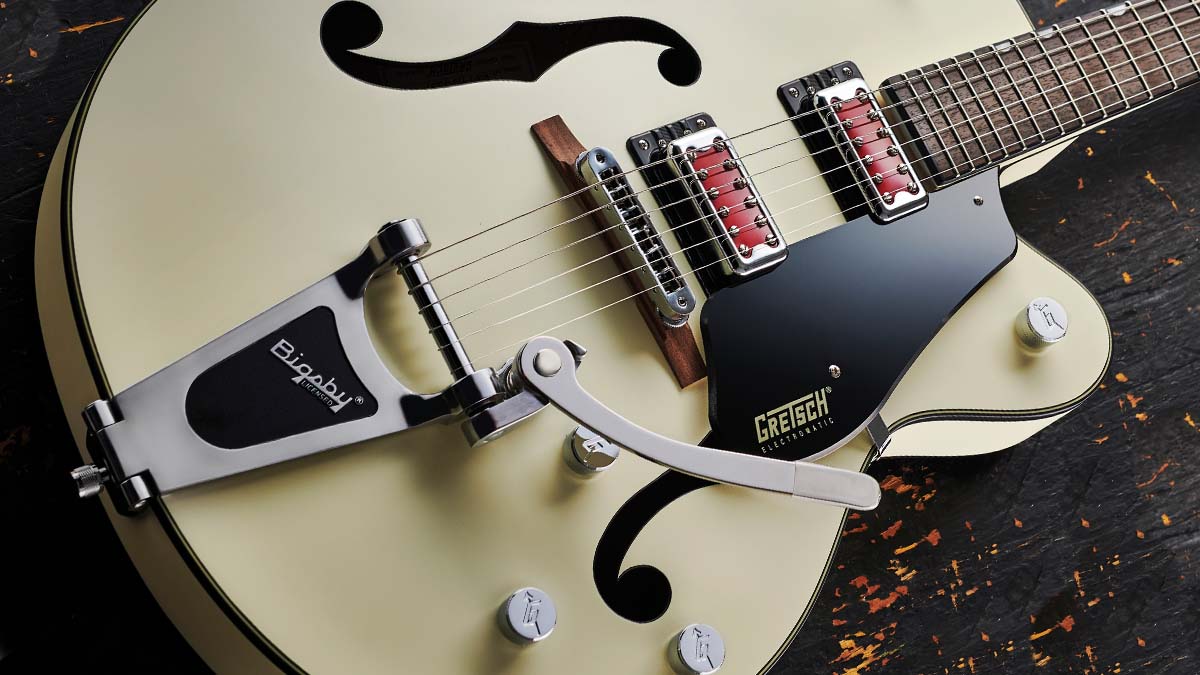Guitar World Verdict
Gretsch takes one of its most iconic designs and gives it a street-ready makeover and offers it up for 700 bucks. It's insanely good value for one of the coolest guitars on the market.
Pros
- +
First off, it looks amazing.
- +
Exceptional tones.
- +
More versatile than you might think.
- +
Very playable.
Cons
- -
A bit more girth in the neck profile would make it perfect.
You can trust Guitar World
If you spend enough time glued to the gogglebox, you’ll find you can’t move for American car-restoration shows. The plots are always a bit on the thin side. And there’s usually a stupid deadline… a deadline that can’t possibly be met.
Yet something that looks as though it was pulled from the trash compactor on the Death Star is transformed into a sleek new conveyance with minutes to spare. Every. Single. Episode.
Quite often these shows will produce something described as a “Rat Rod”. Beloved by rockabilly cats and kittens, these things are the antithesis of megabucks hot-rods with their expensive paint and polished chrome.
Rat Rods generally boast visible wear and tear and flat, primer-style paint. Luckily, the new Gretsch G5410T Electromatic “Rat Rod” that just rolled onto our forecourt has plenty of the latter and none of the former.
Built in Korea, this hollow-bodied behemoth is basically a modified take on the iconic G6120, which is the guitar the doomed rocker Eddie Cochran, Nashville boss Chet Atkins and Stray Cat Brian Setzer all bestowed iconic status upon.
At the heart of the beast you’ll find the top, back and sides pressed from sheets of laminate maple and bound in aged white plastic and black purfling. That’s your cake.
The icing is the 50s-style bound oversized f-holes, classic chrome ‘G-Arrow’ control knobs, not to mention the obligatory old-school wiggle stick, in this case a stiff-feeling but workable licensed Bigsby B60 True Vibrato. The latter is partnered with a six-saddle Adjusto-Matic bridge with an anchored wooden base.

In terms of the electrical appointments, the G5410T comes loaded with a pair of the house Black Top Filter’Tron humbuckers. These are fed into a master volume with treble bleed circuit, a dedicated volume control for each pickup, a master tone and a three-way selector.
Now, the pickups might be called Black Tops but they actually have red inserts. Nowhere in the Gretsch sales literature for this guitar does it explain why these inserts are so cool. They make the Black Tops look like hot-rod tail lights. It must have been deliberate. Someone needs to take a bow.
Befitting the whole Rat Rod thing, our G5410T is coated in Matte Vintage White paint. There are two other finishes available: you can have Matte Black with a red ‘Plexi’ scratchplate, or Matte Phantom Metallic - a cool silver grey - with the same black ’guard as our review model.
If you like ’em thin, you’ll be equally content with the faultless playability. This thing almost plays itself
The Matte Vintage White paint is also applied to the back of our guitar’s 625mm (24.6-inch) scale set maple neck and its headstock face.
Now, considering this is a sub-£1,000 Gretsch guitar, you might expect to find the fingerboard is cut from one of those rosewood substitutes: pau ferro or Indian laurel. You’d be wrong.
The G5410T has a rosewood ’board just like the Professional Series stuff, with aged white binding and late-50s-style pearloid ‘Neo-Classic Thumbnail’ inlays. The smaller late-50s-style headstock plays host to a set of beautiful open-back tuners and a 42.9mm-width Graph Tech NuBone top nut.


Feel & Sounds
The G5410T’s neck profile is slim. It’s described as a ‘U’ profile, which for many of you will likely suggest the identically named fat-as-hell necks on early 50s Broadcasters, Nocasters and Teles. Nope. This is really slim.
Figure in the 22 medium jumbo frets and a reasonably flattish 305mm (12-inch) fingerboard radius and you’ll realise our ‘Built For Speed’ description isn’t just a Stray Cats reference. If you like ’em thin, you’ll be equally content with the faultless playability. This thing almost plays itself.
If there are any footprints in the ointment, they come courtesy of the Bigsby: it’s just not as loose and smooth feeling as the US-made versions. That said, tuning stability is impressive.
Gretsch has taken one of its most iconic designs, customised it to look even cooler, and made it more affordable. The fiends
Acoustically, this guitar is loud. Despite the Gretsch promo material claiming this guitar’s body is 57mm (2.25 inches) deep, it’s actually the same 63.5mm (2.5-inch) depth as a Brian Setzer Hot Rod. That full-bodied delivery feeds right into the pickups.
The bridge pickup chimes as expected when clean but snarls when you start feeding it some gain. Introducing both Filter’Trons to each other adds some warmth to the clarity of the bridge unit for a classic rockabilly voice. This is even more evident when fingerpicking.
Switching to the neck pickup solo works great for jazz comping but also reveals a punchy blues tone when overdrive is kicked in. The clarity of the bridge pickup is echoed by the note separation of the neck unit, which can become satisfyingly unpredictable when you work in an old-school fuzz box.
Some Gretsch Electromatics flaunt the modern tones of the Broad’Tron humbuckers. The G5420T’s Filter’Trons will be more familiar to vintage geeks. This is what a Gretsch should sound like, whether your interpretation of that runs to AC/DC, 60s mod or 50s rock ’n’ roll.





Verdict
Pah! All Gretsch has done is take one of its most iconic designs, customised it to look even cooler, and made it more affordable. The fiends.
Seriously, though, this thing streets at less than £700. So if you’ve been smudging up the music-shop windows dreaming of the day you can have it away on your toes with a Setzer Hot Rod or Nashville, then the G5410T could put you out of your misery.
This guitar couldn’t look any cuter. But it’s about more than just the looks. The pickups actually have enough vintage-style tone to keep the greasers happy, and the kind of grunt that punk cats like Tim Armstrong of Rancid can’t get enough of.
If you fancy this thing, our advice is don’t hang about. Gretsch has a habit of introducing new finishes a bit further down the road and then dropping existing colour codes. So if you like the look you should probably put your foot down. There’s always a deadline, man...
Specs
- PRICE: $799.99 / £809 / €879
- ORIGIN: Korea
- TYPE: Single-cutaway hollowbody electric guitar
- BODY: Laminated maple with sound post
- NECK: Maple, set-in, with aged white binding
- SCALE LENGTH: 625mm (24.6”)
- NUT/WIDTH: Graph Tech NuBone/42.86mm
- FINGERBOARD: Rosewood, 305mm (12”) radius, pearloid ‘Neo-Classic Thumbnail’ inlays
- FRETS: 22, medium jumbo
- HARDWARE: Chrome Licensed Bigsby B60 True Vibrato, Adjusto-Matic anchored six-saddle bridge, vintage-style open back tuners
- STRING SPACING, BRIDGE: 54mm
- ELECTRICS: 2x Black Top Filter’Tron humbuckers, master volume with treble bleed circuit, 2x volume, master tone, 3-way pickup selector toggle switch
- WEIGHT (kg/lb): 3.3/7.3
- OPTIONS: Gigbag $69/99 / £63; hard case $149 / £191
- LEFT-HANDERS: No
- FINISHES: Matte Vintage White (as reviewed), Matte Phantom Metallic, Matte Black
- CONTACT: Gretsch
Ed Mitchell was Reviews Editor on Total Guitar magazine from 2003, and his guitar-modding column, Ed’s Shed, appeared in print on both sides of the Atlantic (in both Total Guitar and Guitar World magazines). He was the Editor of The Blues Magazine from 2012-16, and a contributor to Guitarist, Classic Rock and Louder. He died in October 2022, aged 52. Between them, the websites Guitar World, Louder and MusicRadar host over 400 of his articles – among them interviews with Billy Gibbons, Paul Weller, Brian Setzer, profiles on Roy Buchanan, Duane Allman and Peter Green, a joint interview with Jimmy Page and Jack White, and dozens of guitar reviews – and that’s just the ones that made it online.
“It holds its own purely as a playable guitar. It’s really cool for the traveling musician – you can bring it on a flight and it fits beneath the seat”: Why Steve Stevens put his name to a foldable guitar
“Finely tuned instruments with effortless playability and one of the best vibratos there is”: PRS Standard 24 Satin and S2 Standard 24 Satin review











